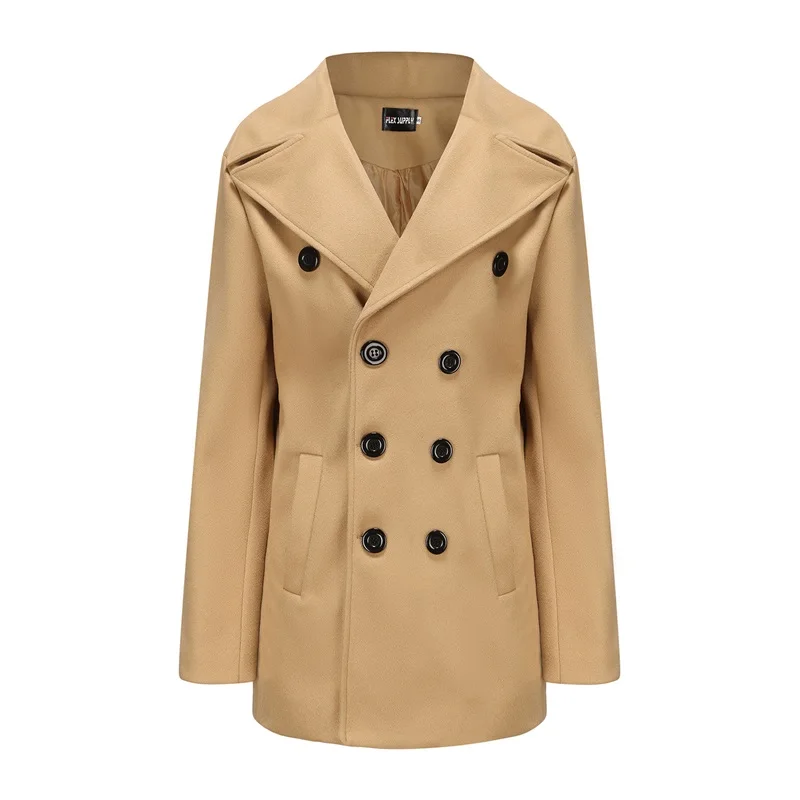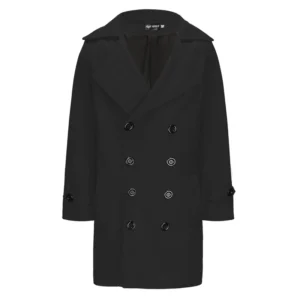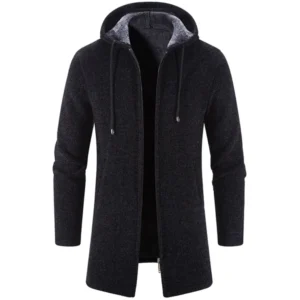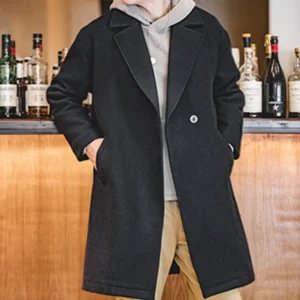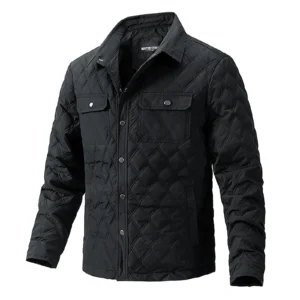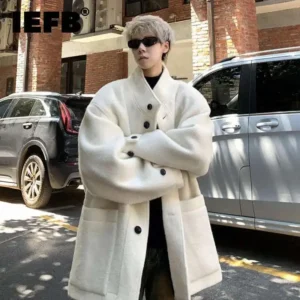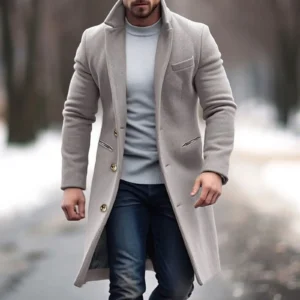Understanding the Classic Pea Coat: Definition and Significance
The pea coat stands as one of menswear’s most enduring and recognizable garments—a short, double-breasted wool coat that has transcended its practical naval origins to become a style staple. When we talk about a “classic fit” pea coat, we’re referring to a specific silhouette that honors the garment’s authentic heritage: a roomier cut through the body with a straight, somewhat boxy silhouette that allows for freedom of movement and layering.
Unlike modern interpretations that might feature a more tapered waist or slimmer profile, the classic fit pea coat maintains proportions that reflect its working-class naval roots. This traditional design serves as more than just an aesthetic choice—it preserves the functional elements that made the coat indispensable to sailors facing harsh maritime conditions.
The name itself derives from the Dutch word “pijjekker,” referring to the coarse twilled navy-blue cloth called “pilot cloth” (or p-cloth) used to make these coats. Understanding the origin behind the peacoat name offers fascinating insights into its development.
Key characteristics that define the classic pea coat include:
- Double-breasted front closure with 6-10 large buttons
- Broad collar that can be turned up against the elements
- Straight silhouette with room for layering
- Hip-length cut, typically ending mid-hip
- Heavy wool construction for maximum warmth and durability
The classic fit pea coat’s enduring popularity speaks to its perfect balance of rugged functionality and timeless style. Even as fashion trends come and go, the traditional mens pea coats continue to offer versatility that few other garments can match, making it essential to understand proper coat length selection for optimal wear.
Naval Heritage: The Seafaring Origins of the Pea Coat
The pea coat’s history is inextricably linked to the high seas, tracing its origins to European naval forces of the 18th century. While many associate the pea coat primarily with American naval tradition, its roots actually stretch back to the Dutch Navy, where the garment first gained prominence. Dutch sailors needed protection against brutal North Sea conditions, leading to the development of a short, heavy wool coat that would allow mobility while working on deck.
By the early 19th century, the British Royal Navy had adopted its own version of this practical garment. The British naval pea coat featured heavy wool construction, a double-breasted front, and a wide collar that could be turned up to protect against biting winds and sea spray. These design elements were entirely functional—the thick wool naturally repelled water, the double-breasted front provided an extra layer of insulation across the chest, and the broad collar shielded the neck and face.
The American Navy standardized its own pea coat design around the 1880s, establishing many of the features we recognize today. The standard-issue American naval pea coat was made from 24-32 ounce Melton wool (a remarkably heavy fabric by today’s standards), dyed navy blue not just for uniformity but because dark colors better concealed the inevitable dirt and grime of shipboard life.
As veterans returned to civilian life after various conflicts, particularly World War II, they brought their military-issue pea coats with them, introducing these practical garments to the general public. The transition from military uniform to civilian wardrobe staple was gradual but inevitable, as the coat’s practicality and distinctive style made it appealing for everyday wear.
Traditional mens wool pea coats maintain many of these original features, preserving the authentic maritime heritage. The mens coat length guide shows how naval proportions have influenced standard measurements in contemporary outerwear.
Defining Elements of the Classic Fit Silhouette
The silhouette of a classic fit pea coat remains one of its most distinctive features, setting it apart from more contemporary interpretations. True to its naval origins, the authentic classic fit follows specific proportions that prioritize function alongside form.
The traditional silhouette features:
- A straight, somewhat boxy cut through the torso
- Shoulders that sit naturally at the edge of the wearer’s shoulder (not extended or shrunk)
- Room through the chest and midsection to accommodate layers
- A moderate hip-length that typically falls around the mid-hip area
- Sleeves cut with enough room for movement without excess fabric
Unlike modern slim-fit variations, the classic pea coat doesn’t taper dramatically at the waist. Instead, it maintains a relatively straight line from the chest to the hem. This deliberate design choice stems from its practical origins—sailors needed to layer heavily underneath for warmth and required freedom of movement to perform shipboard duties.
The classic fit also features a slightly roomier armhole and sleeve than contemporary interpretations. This isn’t a sign of poor tailoring but a purposeful design element that allowed for the full range of motion required for nautical work. The sleeves themselves typically end at the wrist bone when the arms are at rest, providing coverage without restricting hand movement.
Understanding the differences between various coat styles helps when selecting the right option. Many customers find that comparing classic fit vs slim fit pea coats reveals substantial differences in comfort, layering capacity, and overall aesthetic.
Essential Design Features of Authentic Pea Coats
Double-Breasted Front Design
The double-breasted closure represents perhaps the most recognizable feature of a classic pea coat. Authentic designs typically feature 6-8 large buttons arranged in two parallel vertical rows. This isn’t merely decorative—the substantial overlap of fabric across the chest (approximately 6-8 inches) creates an additional barrier against cold wind and moisture.
Traditional pea coat buttons were made from wood, bone, or brass, often featuring naval motifs like anchors on military-issue garments. The buttons are typically secured with a reinforced cross-stitch pattern that prevents them from tearing away during rough conditions.
The spacing of these buttons follows a specific pattern, with the top button positioned to allow the collar to be fully turned up when needed. The bottom buttons typically sit at hip level, allowing the lower portion of the coat to move freely during walking while keeping the torso well-protected.
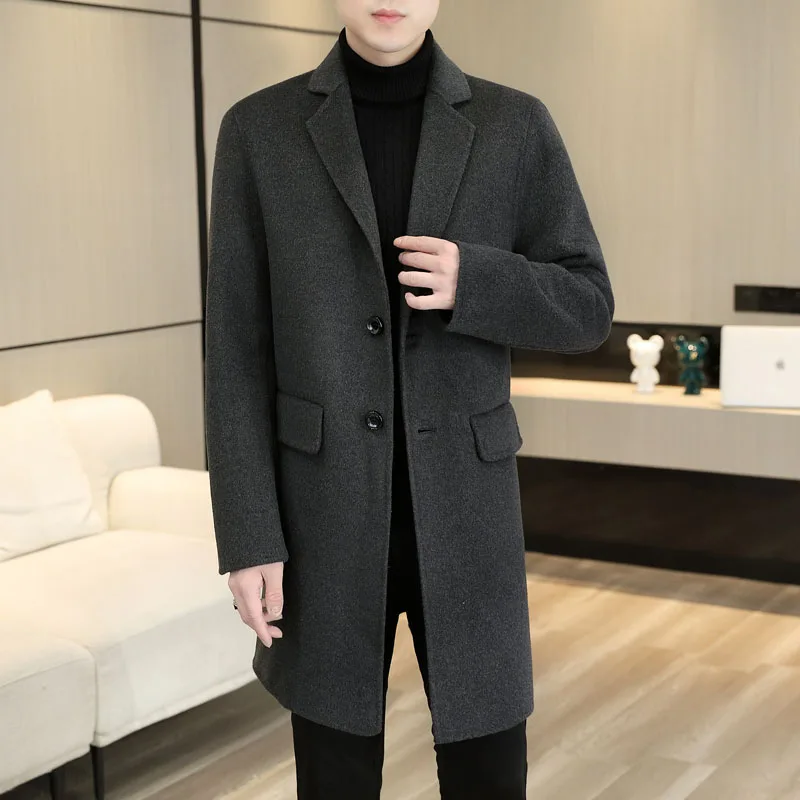
Collar and Lapel Structure
The classic pea coat collar is an engineering marvel of practical design. Known as an Ulster collar, it features a broad, substantial construction that can be worn in multiple positions:
- Folded down in milder conditions, creating a standard lapel appearance
- Turned up against the neck for additional warmth
- Fully closed at the neck with the top button fastened for maximum protection
Many authentic designs include a throat latch—a small fabric tab that can button across the neck opening when the collar is raised, effectively sealing out drafts. This collar structure evolved directly from maritime needs, where protecting the neck and lower face from wind and spray could prevent frostbite and exposure.
The lapels themselves are typically wide and substantial, creating a masculine silhouette while serving the practical purpose of additional chest coverage when the coat is fully buttoned.
Traditional Pocket Styling
The pocket configuration of a classic pea coat reflects both practical necessity and traditional styling:
- Two large vertical or slightly slanted handwarmer pockets positioned at the lower front
- Pockets are typically lined with warm materials for protecting the hands
- Some authentic designs include a smaller internal pocket for valuables
- Military-issue versions sometimes featured specialized pockets for specific equipment
The vertical orientation of the main pockets allows hands to be inserted naturally while standing at attention—another detail that reveals the garment’s military heritage. The pocket openings are generally reinforced with additional stitching to prevent tearing with repeated use.
Exploring our collection of mens double breasted pea coats reveals how these authentic details continue to define quality outerwear. For versatile styling options, our guide on how to style a double-breasted coat offers practical advice for modern wardrobes.
Traditional Materials and Construction Methods
The material composition of a classic fit pea coat is integral to its functionality and appearance. Historically, these coats were crafted from exceptionally heavy wool—typically 24-32 ounce (680-907 gram) Melton or Kersey wool. This dense, tightly woven wool created a naturally water-resistant barrier that could withstand harsh maritime conditions.
The wool undergoes a process called fulling, where the fabric is dampened and agitated, causing the fibers to interlock and create an extremely dense, wind-resistant material. This process gives traditional pea coat wool its characteristic smooth surface and remarkable durability.
Key material aspects of authentic pea coats include:
- Heavy 100% wool outer shell, typically in navy blue or black
- Natural water-repellent properties from the lanolin content and tight weave
- Minimal stretch to maintain shape through years of wear
- Substantial weight (a traditional pea coat might weigh 4-5 pounds)
- Quilted lining, often in satin or flannel, for additional insulation and ease of wear
Construction techniques for classic pea coats prioritize durability and function:
- Reinforced stitching at stress points like pocket openings and button plackets
- Chain stitching at the collar seam for flexibility and strength
- Double or triple needle stitching on major seams
- Bar tacks at pocket corners and vent ends to prevent tearing
- Full canvas or sturdy interfacing to maintain structure
The color palette for traditional pea coats is notably limited. Navy blue dominates as the authentic shade, derived from practical considerations—dark colors show less dirt and wear, critical for military uniforms that needed to maintain a professional appearance during long deployments.
For those interested in the broader category of wool outerwear, our collection of mens wool coats showcases how traditional materials continue to excel in modern garments.
How a Classic Fit Pea Coat Should Wear
Achieving the proper fit with a classic pea coat involves understanding its unique proportions and intended wear. Unlike more fashion-forward pieces, the classic pea coat follows practical guidelines that balance comfort with protection.
When properly fitted, a classic fit pea coat should:
- Allow the shoulder seams to sit directly at the edge of your natural shoulders
- Provide enough room to comfortably wear a sweater or light jacket underneath
- Permit you to fully button the coat without pulling or gapping
- Allow for a full range of arm movement without restriction
- End approximately mid-hip, covering your suit jacket if worn underneath
The sleeves should end at your wrist bone when your arms hang naturally at your sides. This length ensures proper coverage without interfering with hand movement. When wearing a suit or sport coat underneath, approximately ¼ to ½ inch of that jacket sleeve might show beneath the pea coat cuff.
The chest should feel comfortable when buttoned, with enough room for layering but without excessive fabric that creates a billowing effect. A good rule of thumb: you should be able to slide your hand inside the buttoned coat to touch your chest, but it shouldn’t feel loose or baggy.
The classic fit naturally allows more room through the torso than modern slim-fit versions. This isn’t a defect but an intentional design element that provides both comfort and practical layering capacity for colder conditions.
Finding the perfect coat length for your height is essential to maintaining the pea coat’s classic proportions. The right length not only enhances appearance but ensures optimal functionality in various weather conditions.
Identifying Quality in Classic Fit Pea Coats
Distinguishing a high-quality classic fit pea coat from inferior imitations requires attention to several key indicators. When evaluating pea coat quality, consider these essential elements:
Wool Quality and Weight: Premium pea coats use dense, heavy wool with minimal synthetic content. Quality wool should feel substantial to the touch and demonstrate a tight weave with minimal light passing through when held up to a bright source. The weight typically ranges between 24-32 ounces (680-907 grams), creating a sturdy hand feel that promises durability and warmth.
Construction Integrity: Examine the stitching throughout the garment—quality pea coats feature tight, even stitches with no loose threads or puckering. Pay particular attention to stress points like:
– Pocket corners (should have reinforced bar tacks)
– Button attachments (should show cross-stitching for security)
– Collar junctions (should demonstrate clean, reinforced seams)
– Sleeve attachments (should show smooth integration without bunching)
Button Quality: Traditional pea coat buttons are substantial and securely attached. Quality buttons will:
– Feel heavy and solid, not hollow or lightweight
– Show consistent color and finish
– Be attached with a shank that allows room for the thick fabric
– Feature reinforced stitching in a cross or star pattern
Lining Construction: The interior lining should be smoothly attached with no puckering or loose areas. Quality pea coats typically feature:
– Full lining through the body and sleeves
– Secure attachment at all seams and edges
– Interior pockets with reinforced stitching
– Clean finishing where the lining meets facings and hems
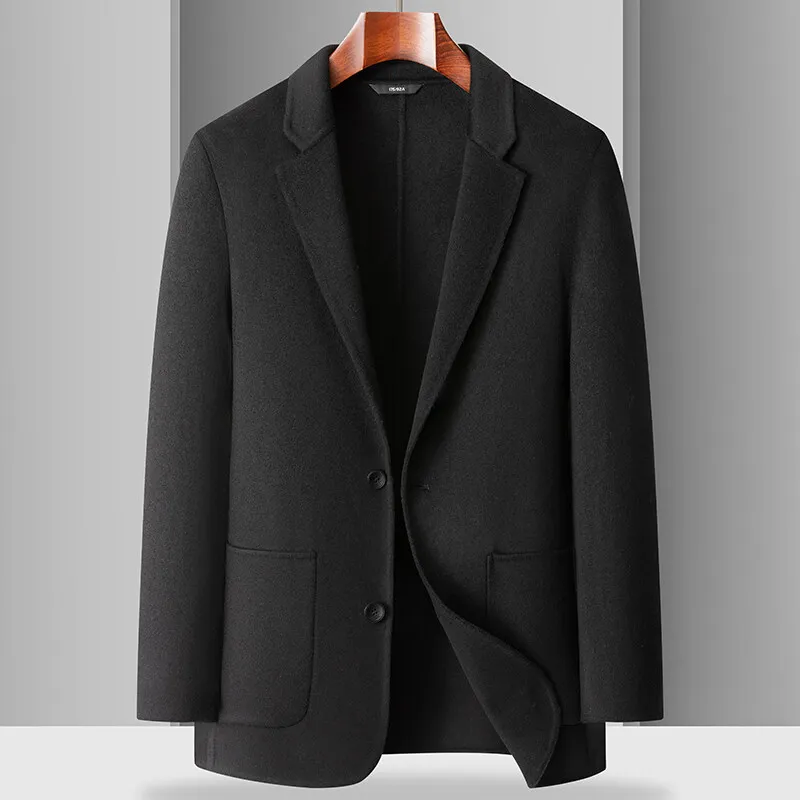
Classic Fit vs. Contemporary Interpretations
As fashion evolves, the pea coat has undergone numerous reinterpretations that diverge from its traditional design. Understanding these differences helps distinguish authentic classic fit pea coats from their modern counterparts.
The most notable differences include:
| Feature | Classic Fit | Contemporary Interpretation |
|---|---|---|
| Silhouette | Straight, somewhat boxy | Tapered, slim through waist |
| Length | Mid-hip (covers suit jacket) | Often shorter, hitting at top of hip |
| Shoulder | Natural shoulder with room | Narrower, more structured shoulder |
| Chest | Allows for substantial layering | Closer to body with minimal room for layers |
| Materials | 100% heavy wool (24-32 oz) | Often lighter wool with synthetic blends |
| Buttons | 6-8 large buttons, traditional spacing | May feature fewer buttons, repositioned |
| Collar | Wide Ulster collar with full turn-up ability | Often narrower with limited function |
Contemporary versions frequently prioritize fashion over function, slimming down the silhouette to create a more “tailored” appearance. While these modern interpretations might appear sleeker, they often sacrifice the practical elements that made the pea coat so effective for maritime use—namely, the ability to layer heavily underneath and move freely while staying protected from the elements.
The material composition also frequently differs, with modern versions incorporating lighter-weight wools (16-20 oz) and synthetic blends that reduce cost but also diminish warmth and durability. Traditional navy blue remains popular, but contemporary designs often introduce a broader color palette.
For those considering different outerwear options, comparing short vs long coats can help determine the best style for your needs. Traditionalists might appreciate our definitive guide to classic navy pea coats for its focus on authentic styling.
Styling the Classic Fit Pea Coat for Today
Despite its heritage as naval workwear, the classic fit pea coat transitions seamlessly into modern wardrobes. Its timeless design allows for versatile styling across casual and formal contexts.
For casual everyday wear:
– Pair with dark denim jeans and a simple crew neck sweater
– Add a colorful scarf for visual interest and additional warmth
– Complete with leather boots for an effortless weekend look
– Layer over a hoodie for a contemporary casual approach
For business settings:
– Wear over a suit or sport coat (the classic fit accommodates this layering)
– Choose complementary neutral colors that work with your professional wardrobe
– Consider dark gloves and a solid scarf to maintain a refined appearance
– Ensure proper coat length to cover suit jackets appropriately
The classic pea coat’s straight silhouette works well for most body types, creating a masculine shoulder line while providing comfortable proportions. Unlike aggressively tailored modern coats, the classic fit doesn’t require a specific body type to look appropriate.
Accessorizing a pea coat follows similar principles to other outerwear—choose complementary pieces that enhance both function and style. A well-chosen scarf adds both warmth and visual interest, while leather gloves complete the polished appearance.
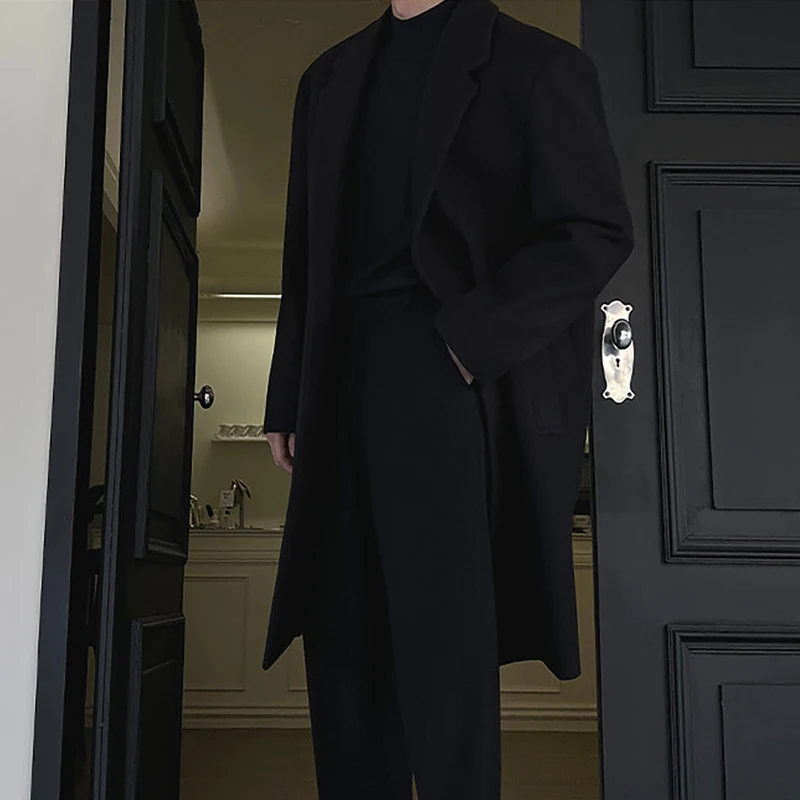
For more comprehensive styling advice, our mens coat length style guide offers detailed recommendations for creating balanced proportions with various outfits.
Mens Double Breasted Pea Coat, Mens Wool Blend Coat, Mens Wool Pea Coat
Price range: $136.84 through $157.36 Select options This product has multiple variants. The options may be chosen on the product pageMens Cashmere Overcoat, Mens Hooded Winter Coat, Mens Wool Blend Coat
Price range: $128.72 through $139.68 Select options This product has multiple variants. The options may be chosen on the product pageMens Black Overcoat, Mens Black Wool Coat, Mens Wool Overcoat
$339.18 Select options This product has multiple variants. The options may be chosen on the product pageMens Double Breasted Pea Coat, Mens Hooded Winter Coat, Mens Quilted Coat
Price range: $81.00 through $108.48 Select options This product has multiple variants. The options may be chosen on the product pageMens Grey Overcoat, Mens Wool Blend Coat, Mens Wool Overcoat
$201.28 Select options This product has multiple variants. The options may be chosen on the product pageMens Long Wool Coat, Mens Wool Blend Coat
Price range: $97.40 through $128.36 Select options This product has multiple variants. The options may be chosen on the product page
Why the Classic Fit Endures: Functionality Meets Style
The enduring appeal of the classic fit pea coat stems from its remarkable balance of practical function and timeless aesthetic appeal. Unlike many fashion items that cycle in and out of relevance, the pea coat has maintained its position as a wardrobe staple for generations.
This staying power can be attributed to several key factors:
First, the classic fit’s roomier proportions provide genuine utility in cold weather. The ability to layer substantially underneath without restriction offers practical warmth that slimmer interpretations simply cannot match. This functional aspect means the classic fit performs its primary purpose—protection from the elements—better than most contemporary variations.
Second, the traditional silhouette creates a masculine, squared shoulder line that flatters most body types without requiring the wearer to have a specific build. This democratic fit makes it accessible to a broader range of men than highly tailored alternatives.
Third, the classic design exists outside fashion’s typical trend cycles. While details like lapel width or button size might see subtle evolution, the fundamental design has remained recognizable for over a century. This transcendence of trends makes the classic fit pea coat a genuine investment piece rather than a seasonal purchase.
Finally, the authentic materials and construction methods used in quality classic fit pea coats create remarkable durability. A well-made example can last decades with proper care—a rarity in today’s disposable fashion landscape. At Metro Cloak, we recognize this heritage of quality and ensure our pea coats meet these exacting standards.
Is the Classic Fit Pea Coat Right for You?
Determining whether a classic fit pea coat suits your needs involves considering several practical factors:
Q: How does a classic fit pea coat work for different body types?
A: The classic fit offers versatility across body types. Its straight silhouette complements larger frames without adding bulk, while creating structure for slimmer builds. The key is proper sizing—the shoulders should align with your natural shoulder edge without drooping or pulling.
Q: Is a classic fit pea coat suitable for my climate?
A: Traditional pea coats excel in moderate to cold climates. The heavy wool construction provides significant warmth in temperatures from around 25°F to 45°F (-4°C to 7°C), especially when layered appropriately. For milder climates, lighter-weight interpretations might be more practical for regular wear.
Q: What maintenance does a classic fit pea coat require?
A: Quality wool pea coats need minimal care. Spot cleaning addresses most issues, while professional dry cleaning once per season is typically sufficient. Proper storage with a sturdy hanger maintains shoulder shape, and occasional brushing removes surface debris while restoring the wool’s natural oils.
Q: How versatile is a classic fit pea coat for different dress codes?
A: The pea coat demonstrates remarkable versatility. It pairs naturally with casual attire but also complements business wear when properly fitted. The classic fit specifically accommodates suit jackets underneath, making it suitable for professional environments.
Common Misconceptions About Classic Pea Coats
Several misconceptions persist regarding classic fit pea coats, often leading to confusion when shopping for an authentic example:
Myth: All short wool coats qualify as pea coats.
Fact: True pea coats specifically feature double-breasted closures, broad Ulster collars, and straight silhouettes. Single-breasted short wool coats are typically car coats or other styles entirely.
Myth: Authentic pea coats only come in navy blue.
Fact: While navy blue represents the most traditional and historically accurate color, black pea coats have long been accepted as classic alternatives. Modern interpretations in camel, gray, or other colors, while fashionable, deviate from the traditional definition.
Myth: A well-fitted pea coat should feel snug like a suit jacket.
Fact: Classic fit pea coats intentionally provide room for layering. A properly fitted example allows comfortable wear over a sweater or light jacket without restriction—snug fits contradict the garment’s functional origins.
Myth: Longer pea coats offer better protection.
Fact: Traditional pea coat length (mid-hip) specifically evolved to allow freedom of movement while providing core warmth. Longer versions technically qualify as bridge coats or reefers—related but distinct naval garments.
Myth: Synthetic blends perform as well as 100% wool.
Fact: While synthetic additions may reduce cost and weight, traditional 100% wool provides superior insulation, natural water resistance, and better temperature regulation. Quality wool also develops character with age rather than degrading.
By understanding these distinctions, you can better identify authentic classic fit pea coats and appreciate the practical design choices that have made this garment a true icon of menswear.

